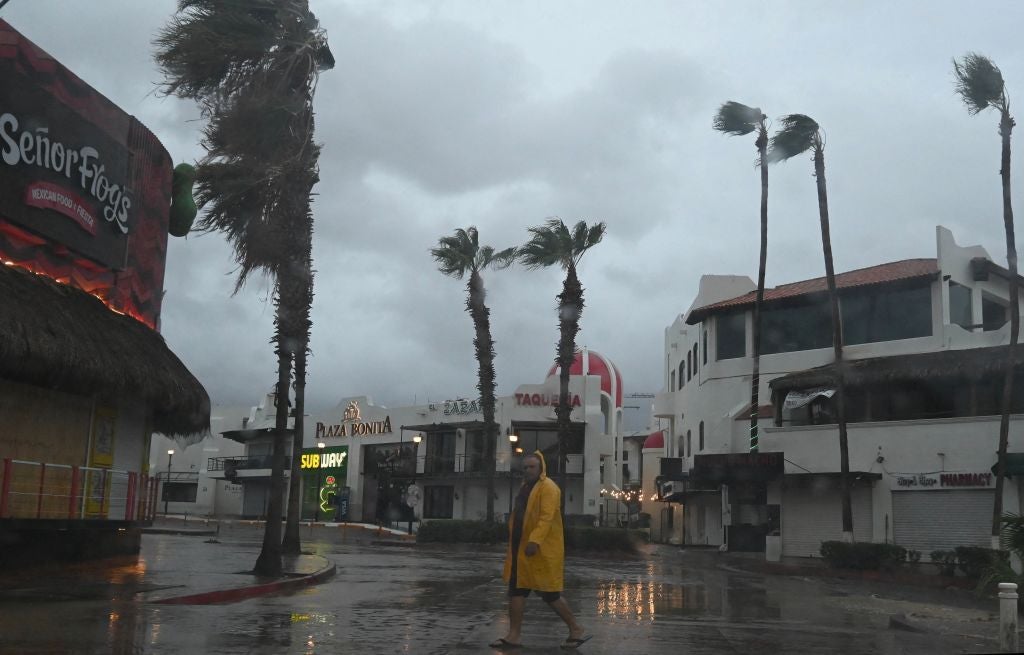Hurricane Hilary bearing down on US as officials warn of ‘very dangerous’ Category 2 storm
Rain over US expected to peak between Saturday and Sunday night
Your support helps us to tell the story
From reproductive rights to climate change to Big Tech, The Independent is on the ground when the story is developing. Whether it's investigating the financials of Elon Musk's pro-Trump PAC or producing our latest documentary, 'The A Word', which shines a light on the American women fighting for reproductive rights, we know how important it is to parse out the facts from the messaging.
At such a critical moment in US history, we need reporters on the ground. Your donation allows us to keep sending journalists to speak to both sides of the story.
The Independent is trusted by Americans across the entire political spectrum. And unlike many other quality news outlets, we choose not to lock Americans out of our reporting and analysis with paywalls. We believe quality journalism should be available to everyone, paid for by those who can afford it.
Your support makes all the difference.Hurricane Hilary continued its journey towards the Baja peninsula and Southern California on Saturday, as officials warned that the storm could bring unprecedented rain and flooding to the normally arid Southwest.
"Make no mistake," Nancy Ward, director of the California Governor’s Office of Emergency Services, said on Saturday in a news conference. "This is a very, very dangerous and significant storm."
"There will be power outages across Southern California," she added.
The heart of the storm, which began Wednesday in the waters off Manzanillo, Mexico, was 285 miles frmo Punta Eugenia, Mexico, and about 640 miles south-southeast of San Diego, California, as of Saturday afternoon.
The hurricane, which weakend to a Category 2 storm on Saturday, is moving north-northwest at 17mph, and sustaining maximum winds of 110mph, according to the National Hurircane Center (NHC), just shy of the windspeeds necessary for a storm to be considered a “major hurricane.”
“Heavy rainfall is expected across the Southwestern United States, peaking late tonight through Sunday night. Rainfall amounts of 3 to 6 inches, with isolated amounts of 10 inches, are expected across portions of southern California and southern Nevada,” the NHC wrote in a Saturday afternoon forecast. “Dangerous to catastrophic flooding is expected.”
Officials said they were particularly concerned about desert regions in California and the Southwest, where the deluge will likely begin in full force tomorrow. The heavy rains could cause flash flooding.

"We’re keeping a very close eye on our desert regions east of San Diego and Los Angeles," Brian Ferguson, deputy director of the California Office of Emergency Services, said on Monday, warning that "some parts of those areas may receive double their yearly amount of water in just a single day."
Across the region, preparations began for the historic storm, which prompted Southern California’s first ever tropical storm warning.
The Mexican army mobilised troops in anticipation of heavy infrastructure damage, The New York Times reports.
Meanwhile, in the US, cities through Nevada and California prepared for extensive precipitation.
Las Vegas handed out sand bags to residents and businesses, while California mobilised the state National Guard.
In cities with large unhoused populations like Los Angeles, outreach teams sought to evacuate homeless encampments in the path of potential flooding.
In Southern California’s San Bernardino County, the communities of Oak Glen, Forest Falls, Mountain Home Village, Angelus Oaks, and NE Yucaipa were ordered to evacuate by the sheriff’s office.
Sports leagues in the US like Major League Baseball and Major League Soccer rescheduled games in Southern California ahead of the storm’s arrival.
Such weather events are exceedingly rare in this portion of the country.
The last time a major tropical storm hit touched down in Southern California was in 1939, where homes were washed away and 48 people were killed.
The climate crisis is making major hurricanes more damaging by increasing the temperature of the ocean and raising sea levels.
Hotter seas fuel hurricane growth, while rising oceans can eliminate natural storm defences like wetlands and make coastal cities more vulnerable.
Join our commenting forum
Join thought-provoking conversations, follow other Independent readers and see their replies
Comments